Last week I displayed four classic Azteca masks. I noted that these were considered to be masks suitable for La Danza de la Conquista (the Conquest Dance), but they actually dance during Carnaval (Carnival/ Mardi Gras). I included several videos that showed these masks in Carnival dances in two towns in Veracruz—Cruz de Ataque and Zacualpan.
Recently when I examined the masks in the James and Jane Urmston collection, I noticed two masks which had striking noses, but neither looked like these classic Azteca masks. The Urmstons, who had collected these masks during a period of years when they were living in Mexico, had the impression that these were also Azteca masks. Where these masks had performed was undocumented. These masks have been sold by the Urmstons, but they gave me permission to publish their photos. I was particularly interested because I had a group of masks that resembled one or the other of these; were they also Azteca masks? To cut to the chase, I ended up with the impression that the two Urmston masks and my similar examples were more likely to be masks from the Santiagos or Santiagueros dance, although they did share with the Azteca masks the trait of large and dramatic noses.
Here is one of the masks from the Urmston Collection. Isn’t it remarkable?
This mask was collected by the Urmstons in the Mexican state of Puebla, in 1980.
I must immediately note that there are decorative masks from the Mexican state of Guerrero that mimic this style, such as one on page 233 of Donald Cordry’s book—Mexican Masks, and another on page 51 of Changing Faces: Mexican Masks in Transition (1985). They have even more elaborate coiled noses. On some of these decorative masks the coiled nose follows a square or rectangular trajectory.
Here is the second of these Urmston masks. This one was collected in the Mexican state of Hidalgo in 1980.
It has a long and gracefully curving nose.
Now I will compare three masks from my collection with these two. You will see how they overlap in their designs, but vary in their details and descriptions. I will start with one that weakly resembles the two above, but comes with the clearest provenance. Written with a marker on the back of the mask are the words—”Turcos/Tenampa/Ver.” Here is that Turcos mask. When I bought this mask from Robin and Barbara Cleaver in 1989, they called it a Diablo.
The teeth appear to have been created from mirror fragments.
On the back is written “Turcos Tenampa Ver.” This mask is 9½ inches tall, 6 inches wide, and 6 inches deep from the back edge to the front edge of the nose.
A patch cut from a recycled condensed milk (LECHE) can Has been nailed to the back for some unknown reason The surface of the back demonstrates a normal pattern of differential wear.
On the web I found a description of the “Danza de los Pilatos.” This is a dance in which the corps of dancers is organized into two groups—Los Maceguales (the name for the laborer class in ancient Aztec society), under the leadership of Santiago Apóstal, versus Los Nahuitas and Los Turcos, together led by Pilato Viejo. Turcos (Turks) refers to Moors; this is language lifted from the Moros y Cristianos dance. Nahua can be a synonym for Aztec, but in Indian Mexico it is also the word for skirt. Therefore Nahuito might seem the equivalent of “Azteca,” but in the Pilatos dance it probably refers to dancers wearing skirts. In a video that follows the next mask, we find one group of dancers with skirts and red faced masks with human noses while other dancers lack such skirts and wear masks with curling noses. The two groups engage in “La Batalla de la botella,”literally “The Battle of the Bottle,” whatever that means. In other words, this is yet another example of a Santiagos or Santiagueros dance that is described as a variation of the Moors and Christians, although the conflict is actually between Santiago and his followers (who in this case are explicitly named for Aztec yomen) versus Pilate and two groups of followers, called the Turks and the Skirts (Nahuitas). Here is the link:
http://www.destinoveracruz.com/danzas/danza-de-los-pilatos.php
The plot thickens when we examine the next mask. It has a far more elaborate spiral nose. Like the first, it has inlaid glass or ceramic chips to simulate teeth and the painted decoration is m/l the same. Unlike the other masks in this post, this one has relief carved ears that are clearly original to the mask. More important still, these are not human ears but the ears of a goat, so we know that this is a mask depicting Satan or some other Diablo. On reflection, this is not so surprising; beings with such deformed noses are clearly not meant to portray humans. Probably all of these masks with unusual noses are Diablos. By such evidence I continue to discover that these so called Moros y Cristianos dances that feature conflict between Santaigo Caballero (with his dance horse) and Pilate are essentially all alike, sharing a hidden plot demonstrating the “true” Christianity of the Indians versus the false Christianity of the Spanish, whose disguised leader is Satan. I had thought that I had just one mask depicting Satan disguised as Pontius Pilate, from Olintla in the Sierra de Puebla, but now I have discovered a second, and this one is from a different cultural area, the Huasteca. Here is this remarkable mask. I bought it from Spencer Throckmorton in 1995. At that time Spencer had an entire wall of his living room that was devoted to masks of Diablos.
Thee teeth are made from ceramic chips. The nose is terrific.
This mask is 9 inches tall, 7 inches wide, and 8 inches deep.
The age and wear on the backof this mask is readily apparent.
Here is a link to an article with a photo of a Turko (or Pilato) dancer wearing one of these curling nosed masks (left click on the first dance photo, the one with a gray-haired woman in the foreground, to enlarge it). This photo was taken in Huatusco, Veracruz.
http://imparcialdehuatusco.blogspot.com/2009/11/espectacular-desfile-de-los-concheros.html
Also here is a link to a dance video in which red suited dancers wear these masks with curling noses, while others wearing skirts have masks with normal noses. The video was recorded in Colonia Guadalupe Chichiquila, Puebla. In this version Santiago does not seem to have a dance horse.
https://www.youtube.com/watch?v=RuRs6oA1c8w
A second dance video, Danza de “Celso Sedas,” also shows these masks in action, again by dancers wearing very tall paper hats. In this video Santiago does appear on the upper left with his usual wooden horse.
https://www.youtube.com/watch?v=GEJM3VlWAt8
In still another video of the Pilatos dance, although not one that uses these masks, I direct your attention to an interesting event beginning after 50 seconds—a Catholic procession blesses the Santiago dancer and his horse with smoke from a burning incense censer.
https://www.youtube.com/watch?v=sw_iuggl-sQ
I purchased a third example of these masks with unusual curving noses from the Eyes Gallery, in Philadelphia, in 1996. Like the Turco, this mask was originally collected by Jaled Muyaes and Estela Ogazón in Veracuz, but the village of origin of this mask is unknown. It was said to be from the dance of “Las Trincheros” (the trench diggers), a most mysterious name. Do they dig with their noses, as if these were plows?
This mask has the grimace that I associate with masks of Moors, but of course it has this non-human nose to mark it as something else, probably a Diablo. Ultimately this seems to represent yet another variation on the central covert theme of the Santiagueros dance—the claim that the Spanish were able to dominate, conquer, exploit, and abuse the Indians of Mexico with the assistance of Satan.
This mask is 7 inches tall, 6½ inches wide, and 6½ inches deep. The back has obvious wear.
In the large and impressive book about the Rafael Coronel collection—La Tierra y el Paraíso—there are several more masks with designs like those in these photographs. One of them, plate 255 on page 217, has virtually the same spiral nose as the one with goat’s ears, although the Coronel mask has human ears. Three others have turned up noses. All four are labeled as Moro masks from the dance of the Moros y Cristianos.
I hope that you have enjoyed seeing these remarkable masks. Next week I will focus on one very special and unusual mask from the Huasteca.




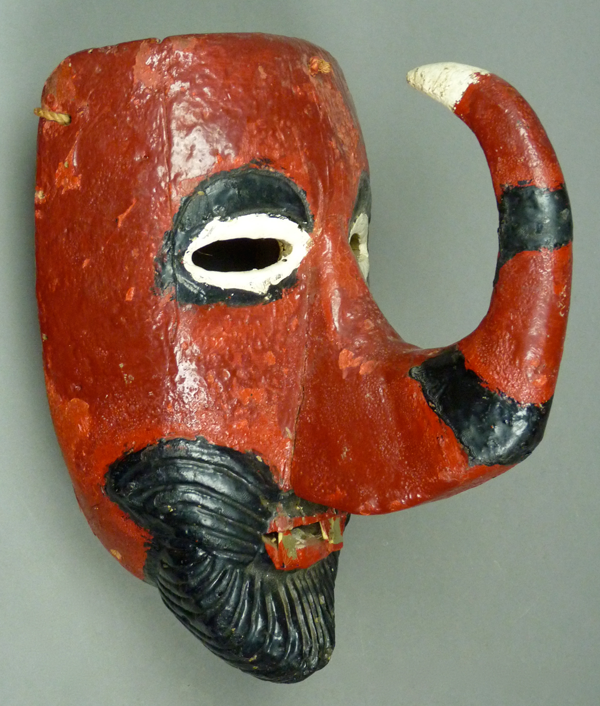
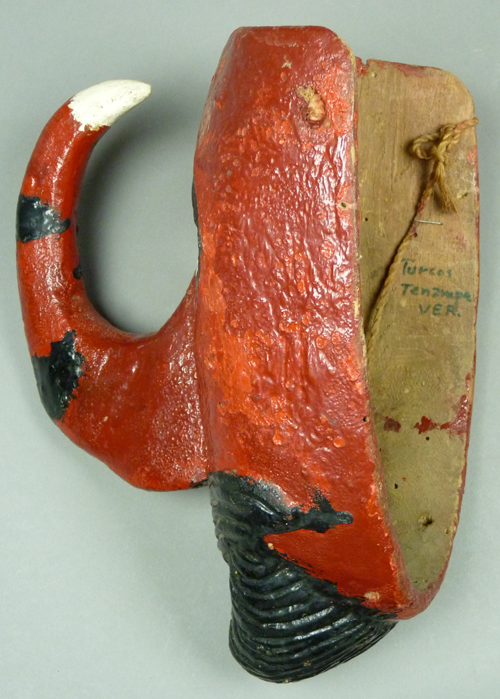
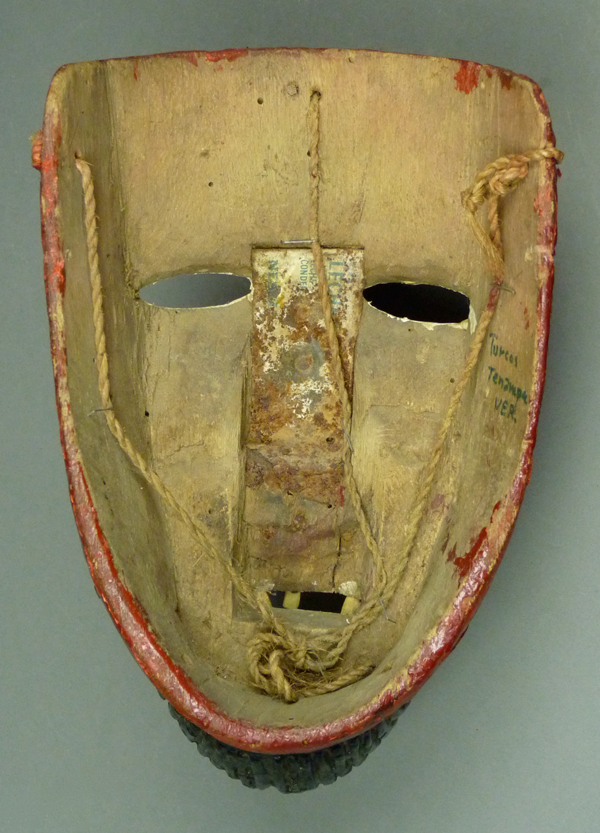
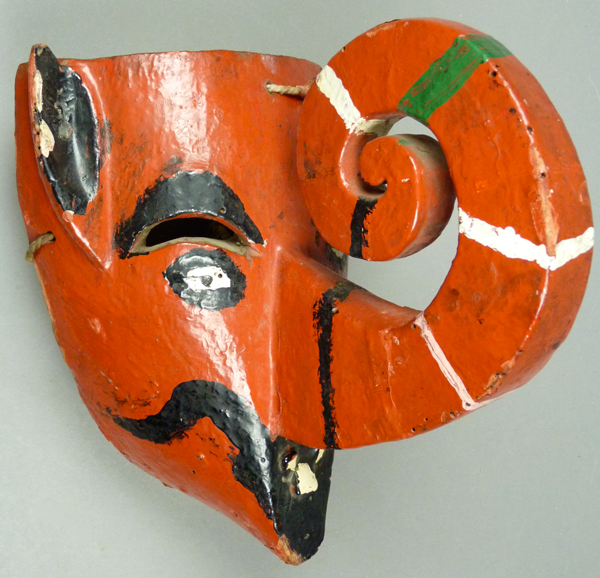
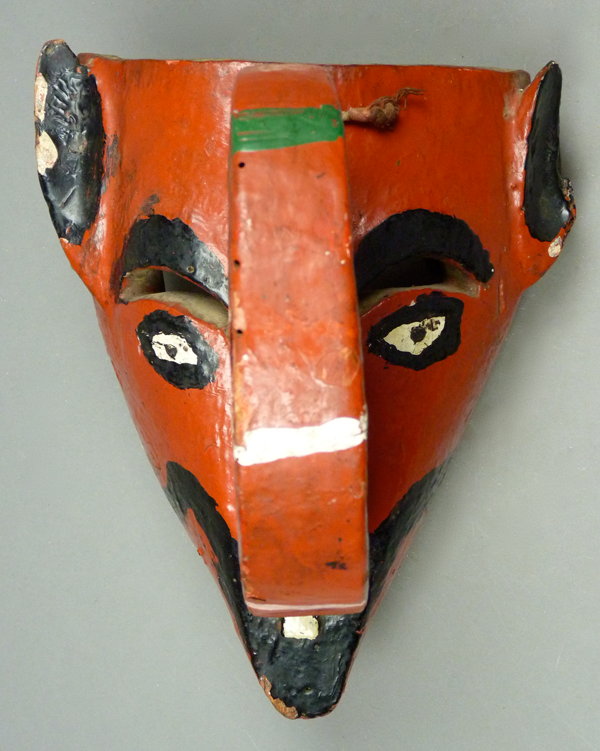
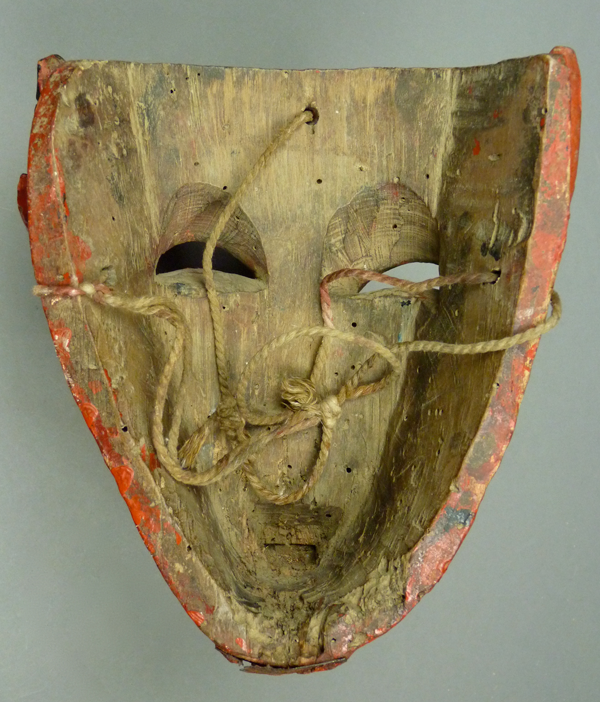
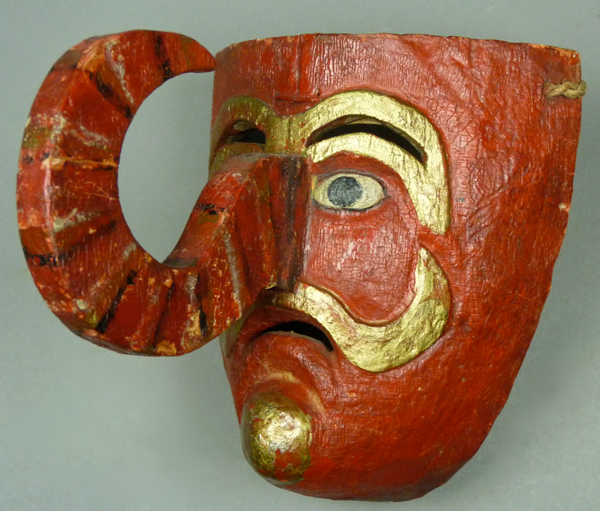
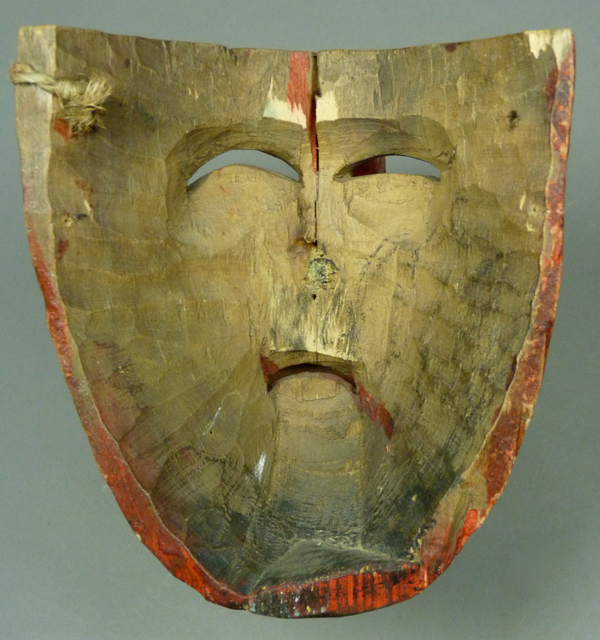
hi Bryan, good morning,
I hope this note finds you in excellent health and great spirits…
It delights me to no end to see the spiral-nosed “Azteca” mask from the Urmston’s collection featured in your wonderful blog this week; the mask has graced the foyer in our home for almost the past four years.
There are several attributes about this mask that I find, as you so generously described, remarkable, but I am perhaps most amazed that, somehow, the spiraled nose survived unbroken, despite crossing the grain several times.
I only recently discovered your wonder-filled Mexican dance mask blog, but have already read and re-read each of your most interesting and very informative entries many times over. I hope that you will continue to share your masks and knowledge of masks and masking traditions well into perpetuity. i’m also hoping that you will consider to continue publishing books on this beautifully diverse subject.
Many thanks for all that you’ve shared,
joris